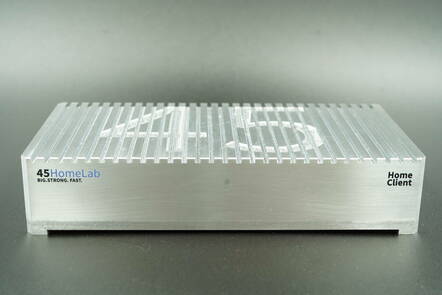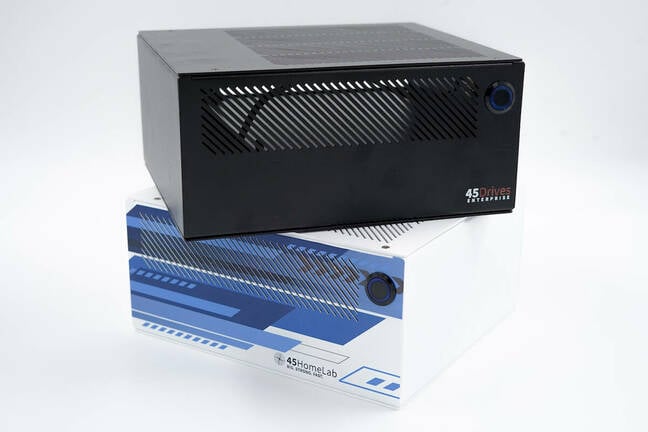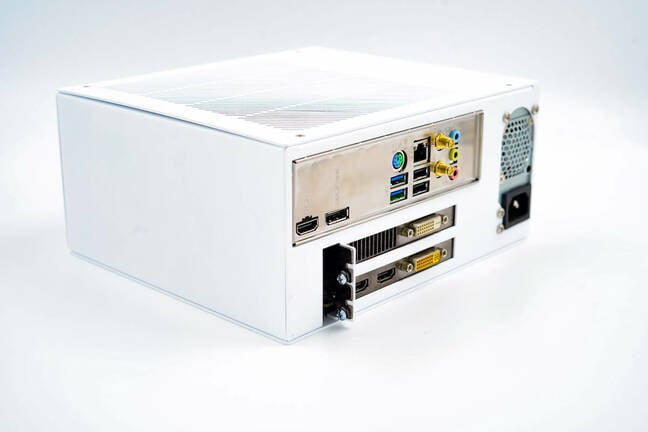Exclusive Canadian systems builder 45 Drives is perhaps best known for the dense multi-drive storage systems employed by the likes of Backblaze and others, but over the last year the biz has expanded its line-up to virtualization kit, and now low-power clients and workstations aimed at enterprises and home enthusiasts alike.
45 Drives’ Home Client marks a departure from the relatively large rack-mount chassis it normally builds. Founder Doug Milburn told The Register the mini PC is something of a passion project that was born out of a desire to build a better home theater PC.

45Drives Home Client is a compact, passively cooled system powered by Intel’s Alder Lake-gen N97 processor – click to enlarge
Housed within a custom passively cooled chassis built in-house by 45 Drive’s parent company Protocase, is a quad-core, non-hyperthreaded Intel Alder Lake-generation N97 processor capable of boosting to 3.6GHz, your choice of either 8GB or 16GB of memory, and 250GB of flash storage.
The decision to go with a 12-gen N-series was motivated in part by 45 Drives’ internal workloads, Milburn explains, adding that to run PowerPoint or Salesforce just doesn’t require that much horsepower.
However, 45 Drives doesn’t just see this as a low-power PC. Despite its name, the box will be sold under both its enterprise and home brands. In home lab environments, these small form factor x86 and Arm PCs have become incredibly popular for everything from lightweight virtualization and container hosts to firewalls and routers.
Speaking of networking, the tiny system comes equipped with a pair of 2.5GbE NICs, which is the bare minimum necessary to use it as a home router or firewall running something like pfSense, OPNsense, or OpenWRT.
While you could run the system headless as a low-power server, the Home Client features dual display outputs — backed by the N97’s integrated UHD graphics — via HDMI and DisplayPort.
Beyond this, 45 Drives’ Home Client is a relatively standard mini PC with front-panel audio, a pair of 10Gbps USB 3.2 Gen 2 ports, along with another two slower 5Gb/s 3.2 Gen 1 ports.
Inside the chassis, there’s a single M.2 B key with support for 2242, 2280, and 3042-sized SSDs as well as an M.2 E key slot, which presumably could be used to add wireless or cellular connectivity. Alongside the M.2 connectivity, the box also sports a single SATA 3.0 header with support for AHCI.
If you’re so inclined, the motherboard also boasts additional expandability via a variety of internal headers for RS-232/422/485, 8-bit GPIO, and USB 2.0 connectivity.
Milburn says 45 Drives also plans to launch a slimmer Arm-based version of the client in the near future, and is experimenting with prototypes based on the Raspberry Pi 5.
Workstation
Alongside the Home Client, the system builder is also launching a small-form factor workstation for customers that need a little extra grunt.

45 Drives’ enterprise (top) and home lab (bottom) workstation come equipped your choice of Intel 12th-Gen Core processors, up to 64GB of RAM, and can be configured with an RTX 4060 graphics card – click to enlarge
The custom chassis features a similar design language to 45 Drives’ storage systems.
Inside the workstation is a fairly standard array of PC components including a mini ITX motherboard and Intel’s Core i5-12600K, i7-12700K, or i9-12900K processors — the latter of which will no doubt benefit from all those fans.
The system can be equipped with between 16GB and 64GB of memory, dual PCIe 4.0 x4 M.2 slots for storage, and a PCIe 5.0 x16 slot for additional expandability.
Where things get complicated is with graphics. The default configuration makes use of Intel’s integrated UHD 770 graphics via the motherboard’s onboard DisplayPort and HDMI ports. However, we’re told that the workstation can be equipped with up to a RTX 4060.
For those using this as a virtualization host running something like Proxmox, XCP-ng, or Hyper-V, this might not be a big deal, but those looking to use this machine for heavier desktop apps may find the form factor somewhat limiting.

45 Drives Workstation can be equipped with a dual-slot GPU upto an Nvidia RTX 4060 – click to enlarge
Unlike the mini PC, 45 Drives’ workstation lacks the dual NICs, and is instead limited to a single Realtek 2.5GbE NIC. With that said, it does come equipped with Wi-Fi connectivity out of the box. The workstation isn’t the most powerful out there, Milburn admits.
“We looked at what the upper end of what we run as a workstation was. We do video editing here; we have about 60 seats in SolidWorks CAD, which is pretty graphics intensive; and we run, on the other side, circuit board CAD and simulation,” he said. “It’s not intended to blow the doors off or anything, but it’s sized for that sort of industrial level of workload.”
Linux first systems
In terms of software, 45 Drives says it will offer a number of operating system images for customers to choose from at the time of purchase, and Linux will be a first-class citizen on these devices.
It’s safe to say that Milburn isn’t a big fan of Microsoft these days. “We run many hundreds of Microsoft workstations here, but we’re kind of moving away from it,” he said. “With Microsoft, it’s a control thing; it’s forced updates; it’s a way of life with them.”
Milburn also isn’t a fan of Microsoft’s registration requirements and online telemetry. “We want control over what all our computers do. We want no traffic on our network that’s out of here,” he said.
As a result, Milburn says 45 Drives is increasingly relying on Linux, and that not only applies to its internal machines but its products as well.
Having said that, we’re told that 45 Drives recognizes that Linux may not be appropriate for everyone and will offer Windows licenses at an additional cost. And, these both being x86 machines, there’s nothing stopping you from loading your preferred distro or operating system on them after they’ve shipped.
Pricing and availability
On the topic of pricing, this may be one of the more difficult aspects of these boxes for customers to swallow.
They aren’t exactly cheap, at least not compared to similarly equipped N95 and N100 systems you’ll find from no-name brands on Amazon and other retailers. It’s a similar story with the workstation, which starts at $1,099, and that’s without the dedicated GPU.
These price tags will no doubt turn off many budget-conscious home labbers looking to maximize on performance per dollar. However, this wouldn’t be the first time, 45 Drives has caught flack from the community over pricing.
When it launched its first home lab appliance – a consumer version of its 15-bay enterprise storage appliance – last year, many expressed disappointment at its price tag. The HL15 will set you back $799-$910 for the bare chassis if you opted for the PSU or not. Meanwhile, a pre-configured system would run you $1,999 before factoring in drives.
Depending on whether you came from an enterprise background or got your start buying up retired servers from e-waste recyclers, 45 Drive’s pricing either sounded like a good deal or highway robbery.
“The reason I love home labs is because they’re ruthless. If they don’t like what you’ve got, they let you know, and they will… suggest better ways to do things,” Milburn said, who likened the company’s pricing to cars.
“Your Kia or your Hyundai will get you to and from work. A Mercedes is just built a little better, and everything is a little nicer and feels better, and a little better performance,” he said.
Milburn was also quick to highlight the fact these machines are being assembled in North America by properly paid employees, which is going to contribute to higher costs.
Consumer versions of 45 Drives’ Home Client and Workstation are available for purchase starting today, with enterprise versions of each in the works. And if you’re looking for something a bit more powerful, say for running VMs, you might want to check out the Proxinator systems the company launched last month. ®




















